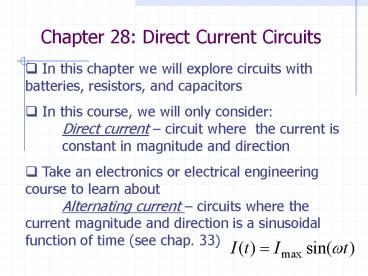Chapter 28: Direct Current Circuits - PowerPoint PPT Presentation
1 / 11
Title:
Chapter 28: Direct Current Circuits
Description:
In this chapter we will explore circuits with batteries, resistors, ... (for NASCAR fans) ... The car stores the excess charge like one plate of a capacitor ... – PowerPoint PPT presentation
Number of Views:86
Avg rating:3.0/5.0
Title: Chapter 28: Direct Current Circuits
1
Chapter 28 Direct Current Circuits
- In this chapter we will explore circuits with
batteries, resistors, and capacitors - In this course, we will only consider Direct
current circuit where the current is constant
in magnitude and direction - Take an electronics or electrical engineering
course to learn about Alternating current
circuits where the current magnitude and
direction is a sinusoidal function of time (see
chap. 33)
2
- Instead, we will consider power supplies, like a
battery (e.g. in a car or flashlight) - Lets consider batteries in more detail
- To maintain a steady flow of charge through a
circuit (DC or direct current), we need a charge
pump a device that by doing work on the
charge carries maintains a potential difference
between two points (e.g. terminals) of the
circuit - Such a device is called an emf device or is said
to provide an emf ? - A battery is a common emf device. Solar cells and
fuel cells are other examples. - emf ? electromotive force. An outdated term. It
is not a force, but a potential difference.
3
- Batteries are labeled by their emf ?, which is
not the same as ?V - Batteries are not perfect conductors
- They also have some internal resistance, r, to
the flow of charge - Therefore, the potential difference (or terminal
voltage) across the battery terminals is given
by - ?V and ? are only equal when I0 ? open
circuit - Now, across the resistor
4
- Or the circuit current is
- Usually, Rgtgtr, so that the internal resistance
can be neglected, but not always - What is the power supplied to each element? From
PI?V
Power supplied by emf
Power lost to internal resistance
Power delivered to load
5
Example Problem 28.4
- An automobile battery has an emf of 12.6 V and an
internal resistance of 0.080 ?. The headlights
together present equivalent resistance of 5.00 ?
(assumed constant). What is the potential
difference across the headlight bulbs (a) when
they are the only load on the battery and (b)
when the starter motor is operated, taking an
additional 35.0 A from the battery?
6
Example Problem 28.6
- (a) Find the equivalent resistance between points
a and b in the figure. (b) A potential difference
of 34.0 V is applied between points a and n.
Calculate the current in each resistor.
7
Example Problem 28.24
- Using Kirchhoffs rules, (a) find the current in
each resistor in the figure. (b) Find the
potential difference between points c and f.
Which point is at the higher potential?
8
RC Circuits
- For the circuits considered so far, the currents
were constant - Lets now consider a case where the current
varies with time (not sinusoidal) - Consider the resistor and capacitor wired in
series
- The capacitor is initially uncharged
- An ideal emf source is attached (r0)
- At t0, throw the switch
9
Charge and current as a function of time for
charging
- Current
- Charge
10
Discharging the capacitor
- Remove emf from the circuit
11
Example Problem (for NASCAR fans)
- As a car rolls along the pavement, electrons move
onto the tires and then the car body. The car
stores the excess charge like one plate of a
capacitor (let the other plate be the ground).
When the car stops, the charge is discharged
through the tires (which act as resistors) into
the ground. If a conducting object (fuel
dispenser) comes within centimeters of the car
before all of the charge is discharged to the
ground, the remaining charge can create a spark.
If the available energy in the car (delivered by
the spark) is greater than 50 mJ, the fuel can
ignite. A race car can accumulate a large charge
and, therefore a large potential difference (with
the ground) of 30 KV. Assume the capacitance of
the car-ground system is C500 pF and each tire
has a resistance of 100 G?. How long does it take
the car to discharge through the tires to the
ground for the remaining energy to be less than
that needed to ignite the fuel?































